2018 Social Media Marketing Law Firm Guide – Gateway to Your Success
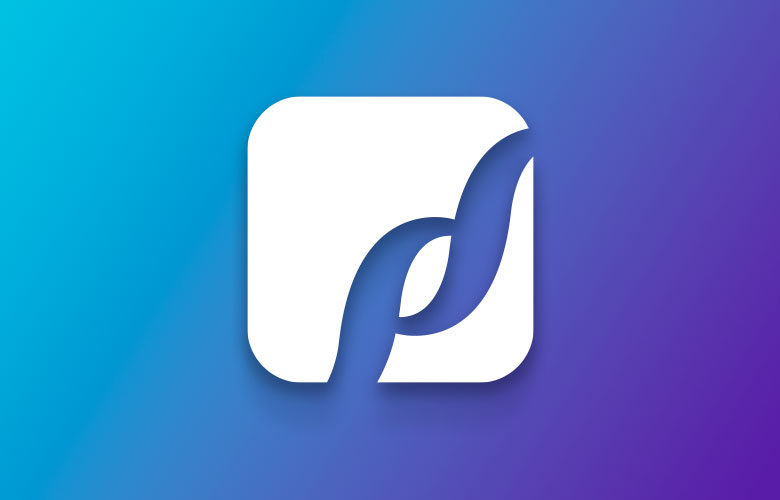
There are plenty of social media platforms out there to help your legal brand gain traction — and you’re likely intrigued but simultaneously skeptical — not of the efficacy of these platforms, no; rather, you’re unsure which platforms are going to give you the most bang for your buck, so to speak.
As far as brands go, it’s best to have a social presence on “the Big Five”: Twitter, LinkedIn, Facebook, Instagram, and Pinterest. For legal brands, however, things are a little trickier. Not only do you want to go where your audience lives, you’ll also want to go where other professionals in your sphere already are.
Why?
Because this tells you that there’s a degree of compliance from other firms that want to market themselves on social media but also have to adhere to and be cognizant of state bar rules. The American Bar Association calls it a “minefield of social media and legal ethics,” while still acknowledging the crucial position that social media marketing can support.
The other thing to consider, as the older generation ages out of a variety of professions, is that more and more incoming lawyers on a global scale, especially those starting up their own practices, are “digital natives.” They’re used to social media as a part of their lives — so turning to it as a lead generation and marketing tool is a no-brainer.
The trifecta of Twitter, Facebook and LinkedIn is perfect for legal eagles because those sites are all primarily about building a network. Instagram is perfect for influencers, and both YouTube and Pinterest are basically search engines and a resource library, respectively. However, the unique tools and interactions that have evolved from these platforms — and which these platforms have evolved for — are all about social networking, in the most original sense of the term.
In this article, you’ll learn the “Do’s” and “Don’ts” of each platform, so you can better understand how to harness each of these platforms for your law marketing efforts, employ each platform in the service of better quality leads; engage authentically, and establish your brand as a thought-leader in your niche.
Twitter is one of those platforms that has survived the big turnovers, while other platforms like “Digg” and “Foursquare” simply crumbled away into obscurity. Twitter is the defending champion against marketing gurus who said that the platform has to evolve its functionality to eliminate the digital noise and information overload. Staying strong as the platform of choice for real-time conversation, Twitter has provided authentic human-to-human interaction and meaningful connection between businesses, brands, culture vultures, celebrities, writers and average Joes.
So lawyers, listen up — wherever your customers are is where you should be. And Twitter is one of those digital “places.”
Do’s
Monitor the goings-on
One of the most powerful features of Twitter is its search functionality. Using relevant hashtags, you can search the most relevant keywords and trending hashtags that will help you clue into what people are talking about, and where and how — based on these “topic” hashtags — you might be able to add value.
For example, if you’re a New York-based law firm, you can chime in about cases or governmental policies by using the hashtag “#nypoli”. Tweets that include hashtags are 33% more likely to be retweeted.
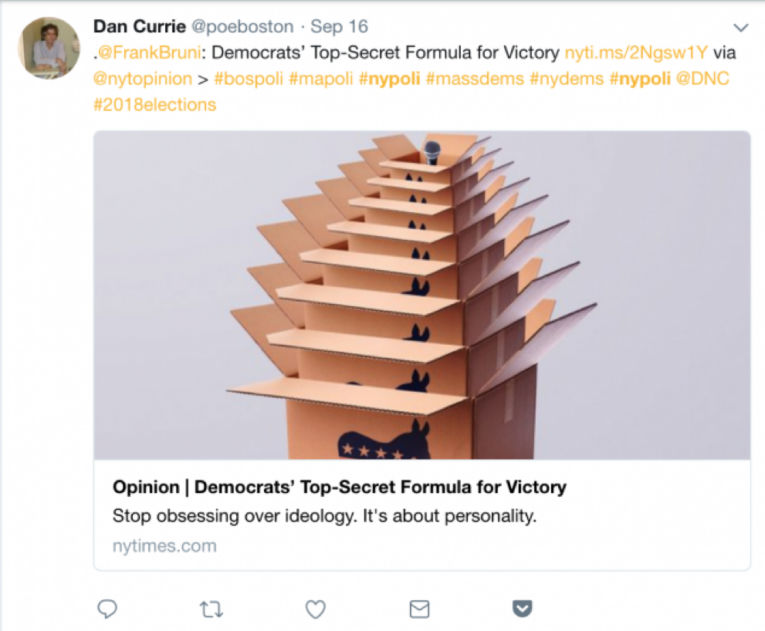
Using this hashtag search, you can view the “tweets” that are being sent out on this topic, and then you can include the trending hashtags in your own tweets to add to the conversation.
You can also broadcast your own firm’s cases by using more “casual” hashtags (like “#LawyerLife”), which are not directly geared towards trending issues or topics but still circulate and gain traffic in your sphere.
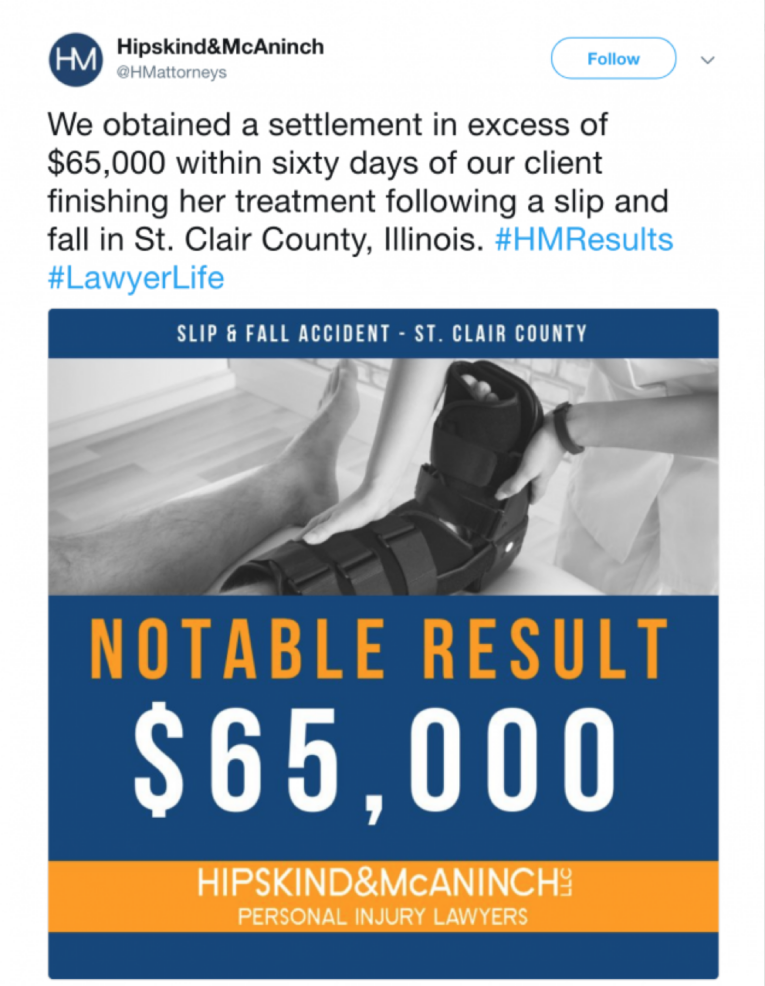
Install a dashboard
As you gear up on your Twitter strategy, you’ll want to make sure that you’re not only posting regularly but that you’re also repurposing content that comes from your blog and sharing industry news.
Many law firms use a social media editorial calendar to organize their Tweets, Facebook posts and more. But what if you’re looking for a way to organize your social media posting, engagement and analytics? Using a dashboard like Hootsuite, Social Oomph, Meet Edgar, Co-Schedule or Buffer, just to name a few, law firms can begin to organize their posting calendar, pre-set their content and schedule it out for auto-posting, and track conversations, comments and re-tweets across various social platforms. These dashboards also usually include analytics that will give you stats on the performance of your tweets, the best times to post and more.
Track links
Use a link analysis and URL shortener tool like “Bit.Ly” or “Click-to-Tweet” to track the performance of your Tweets and traffic. Use this data to create tweets that will generate the most conversation with your audiences.
Remain consistent in posting, graphics and themes
This lawyer used a mix of consistent hashtags and consistently stylized and branded graphics to create a stream of Tweets under the topic “Weird Laws”, that posts on a consistent basis, every two days.
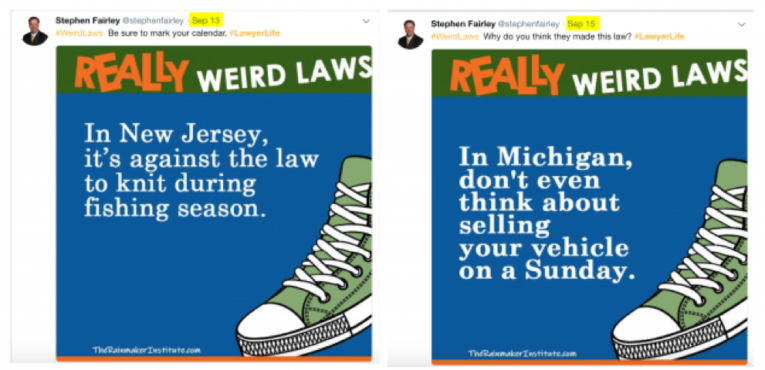
To create your own graphics, turn to an online graphic creator like Canva. Since tweets with images are 34% more likely to get retweeted than those without, you could even include a GIF or a stock photo, especially if your firm doesn’t have branded graphics or a brand guide.
Start and maintain conversations in the “Twittersphere”
Remember that your main “raison d’être” in the Twitter-verse (or Twittersphere, whichever you prefer) is to actively engage with your audiences. These are individuals who could be potential customers, sure, but they can also be your contemporaries in a niche. This is especially useful when you’re weighing in on a topic of national or local community significance, beyond the individual.
Use Twitter, like all other social platforms, to start a conversation, chime in and bring value to others using your expertise. Your end goal may be clicks and conversions but it starts with bringing value and providing high quality content that others will find useful. Remember that 15% of Twitter users unfollow a business within 3 weeks if they don’t make a strong effort to engage early.
So keep the conversation going. You can also opt to use direct message campaigns, which have been proven to be far more effective (up to 300% more) than email campaigns — when done right. Direct messaging has an instant effect but the trick is to message the right people. You can get granular with personalization in a DM message and send your campaigns to a segmented group of followers.
Dont’s
Leave your profile empty
Okay, you’ve claimed all the vanity URLs on all the social networks worth having a presence on before anyone else did. But did you also forget to fill out your profile? Make sure to populate each of Twitter’s open or empty spaces with your own branded copy, content, photos, links to your homepage, information about your firm and more before ever “Following” anyone. You’ll also want to have your profile match your target audience and the services you provide.
For example, Foci Law focuses exclusively on personal injury cases, a specialization that is clear through their choice in header, profile picture, graphics and tweet content.
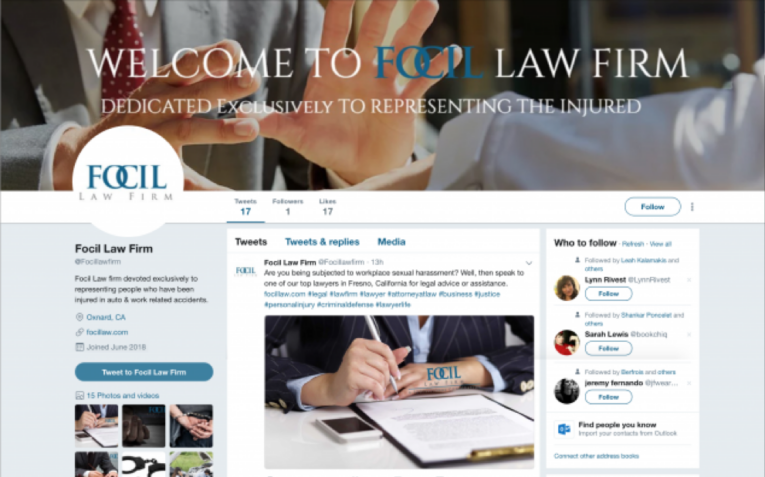
Meanwhile, Allens International focuses on legal matters affecting businesses and individuals on a global scale. You’ll note that their header image conveys that “global” sense:

And their most recent tweet includes a graphic about the “CDR” or “Consumer Data Right” in Australia.
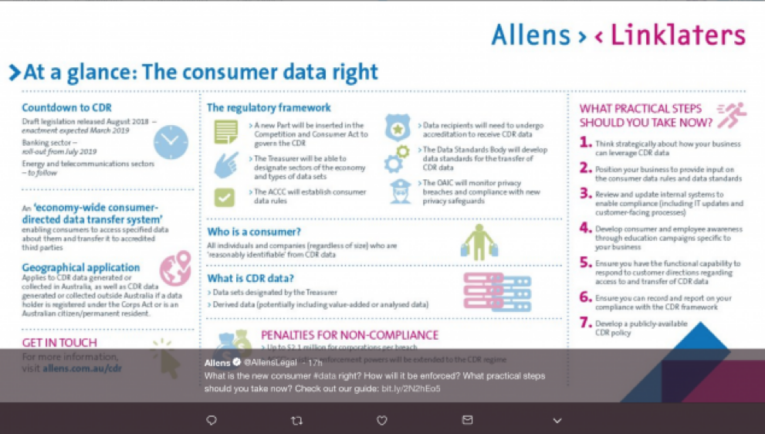
Make your Twitter feed a “me-me-me” parade
The biggest mistake that marketers make is confusing social media networks for social media platforms. In other words, they think that this is a pulpit for broadcasting their wins, their advantages so that they can get more leads.But social media is all about the opportunity to connect with other individuals — whether you stand to directly “gain” a client from your efforts it or not.
Make sure to broadcast any wins from your industry and highlight what others are doing as well, besides pushing out your own. Formulate tweets that connect specific, local or national legal issues with your own expertise and experience.
Outsource or automate your interactions
Your audiences can always tell when you outsource replies, comments and retweets. While you can certainly load up your social media calendar and use a dashboard to pre-schedule Tweets, make sure that your responses and comments are live.
Miss following up after a Twitter-based marketing campaign
Did you know that 90% of companies using a Twitter-based marketing campaign then fail to follow up with their newfound followers in any real way? If you’re spending the ad dollars on a marketing campaign, make sure you’re also creating plenty of opportunities for engagement and online conversations.
Make your personal opinions the highlight
Broadcasting and operating as a law firm in the Twitter-realm is a little tricky because you’ve got to abide by your state bar rules on “ethical Tweeting”, especially when cases are in session. But it also becomes tricky when you’re in a politically charged climate or country. You may see potential for public commentary in multiple spheres and an opportunity to contribute your professional expertise.
That’s okay — beneficial even. But you’ll want to keep your personal opinions separate from your professional Tweets because you are, after all, trying to build a public brand.
As a platform, LinkedIn first started out as a social network that was intended to connect job hunters and companies to promising new talent. While HR departments could post job positions and create “company” pages, candidates could use their profile to list their job history in a visually appealing and readable way. Connections could also reach out, professionally, to others in their “network” to gain testimonials and “endorsements” for the skills and achievements.
Over the years, LinkedIn’s functionality has enhanced and its purpose clarified. Along with the messaging function, users are also able to post and publish external and native content, videos, and, like Facebook, use targeted advertising to be able to tailor content to audiences and promote postings.
With LinkedIn’s modern networking goals, you can use the platform strategically to attract new clients and referral partners.
Do’s
Create a business page
The first thing you’ll want to do is set up a business page. Every aspect of the page, which essentially acts as your company’s profile and your chance to build your brand on LinkedIn, requires you to populate it with information and graphics.
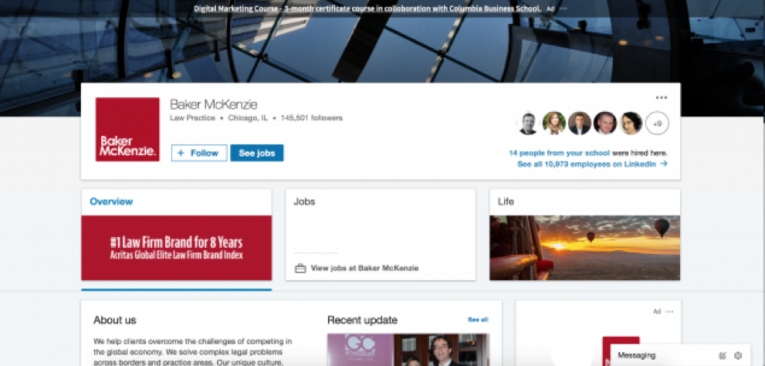
Filling this out is the first step to your LinkedIn success.
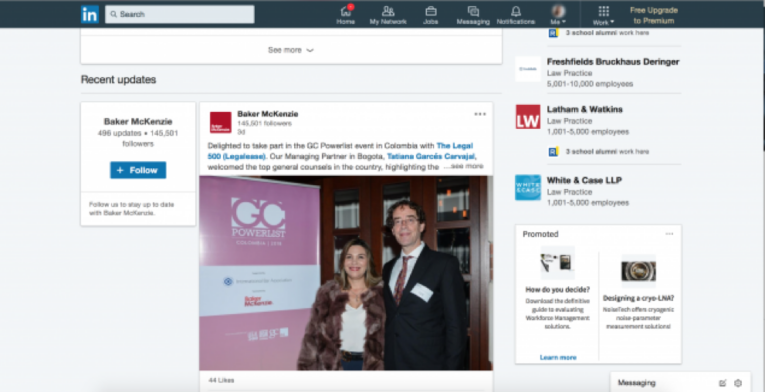
To make Company pages work for your law firm, you want to actively engage on a consistent basis. You can benefit from increased interaction with other lawyers, strategic alliances, referral sources, and prospective clients.
Have each of your firm lawyers create a strong LinkedIn profile
There’s a compelling reason for strong and comprehensive LinkedIn profiles: they convert. After spending around 3-5 hours on LinkedIn, prepping his profile, a small business lawyer in North Carolina, Mark Poniatowski, gained $12,000 worth of referrals. Meanwhile, an employment lawyer at Manning Curtis Bradshaw & Bednar, LLC, credits LinkedIn with helping him to create his personal-professional brand around recognition and expertise as an employment and commercial litigator. To build up his reputation, Tyson Snow frequently answered questions posted in LinkedIn groups. Investing your energy in branding and engagement on LinkedIn can pay dividends when done well.
Engage in commentary and conversations
Just like Twitter, LinkedIn requires professional, individual lawyers to engage and create a rapport with their audience and within their networks. Take the time to post links that you know your network would find useful and, as on Facebook, preface the post with a couple of key takeaways and thoughts.
Use the publishing tool
As a matrimonial lawyer, Joleena Louis writes articles on LinkedIn discussing the issues and concerns many solo attorneys face. These are the posts, published through “In” Publishing, that led Joleena to have coffee with a solo lawyer from California, building her network. Over half of her clients also mention finding her or knowing her from consistent posting, which allows her to build a rapport more quickly and easily.
Curate and “share” knowledge
Every LinkedIn member is armed with a “News Feed”, rather like Facebook. It works on the “back end” of each account user; while non-members and members alike can view individuals profiles, and these are indexed by the web, the News Feed is unique to each user.
Recently, LinkedIn’s “algorithm” has shifted, in order to enable more authentic interaction between members. If you happen to “Like” or “Comment” on someone else’s post, you’ll receive more updates from that same individual or within that same niche. This means that once you gain traction and your network starts to comment, like or even share your content, you’ll be in the right position to populate others’ News Feeds with an increasing amount of content.
Dont’s
Stay away from video
Video is evolving on every platform. From Instagram to Facebook Live, video marketing converts far more effectively than traditional content. Mix up your linked content with a few live videos, and you’ll begin to build your expertise, capturing audiences’ attention far easier.
Use the platform as a distributor of non-native content
LinkedIn, like Facebook, prefers content that is “native”. That means that your videos, for example, should be created and published right on the platform, as this will receive more engagement and greater visibility than simply a linked post to a video.
Mix up your audience
On LinkedIn, you’ll have a chance to interact both with professionals in your “network” as well as potential job candidates. Your job is to craft a content strategy that anticipates both of their preferences and post accordingly. You can use LinkedIn targeted audiences for this. But make sure to keep the two apart. The streams, as they say, should not cross when it comes to sponsored or “promoted” posts.
Send invitations without a plan
Invitations and requests to connect with other individuals can be a tricky thing. You want to handle it in a personable manner, rather than crafting a message that feels canned and generic. Make sure you’ve thoroughly researched the individual you’re hoping to send an invitation to, and tailor your message to their habits or online presence, offering something instead of making an ask.
Post content without a plan
Facebook’s prolific rise is far too lengthy (with too many ever-changing algorithms) to truly track over the decade-plus that the social media giant has been around.
Suffice it to say that its strategic evolution and slow and steady acquisition of now-sister platforms and apps like Instagram and WhatsApp have made it the leader that lays the path for all other social media networks to come — at least for the foreseeable future.
Facebook is more than just friends catching up and cat memes. Using a smart combination of Groups, Business Pages and Ads Manager, you can create your entire headquarters on Facebook — if that’s what you want to do.
Do’s
Set up a Facebook page for your business
Like LinkedIn, Facebook has personal profiles for users known as “People”. But it also has “Pages”. These are further split by topic and category. One of these is “Business Pages”.
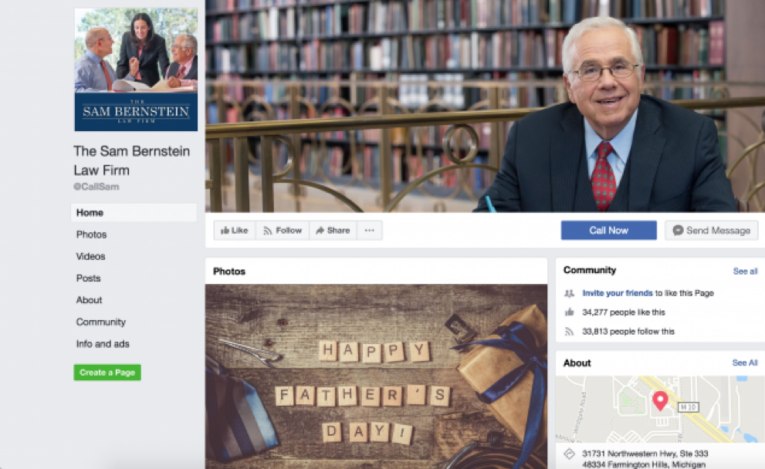
You’ll see that there are various parts to a business page, including an About section with a map and address, photos, videos and a messaging function.
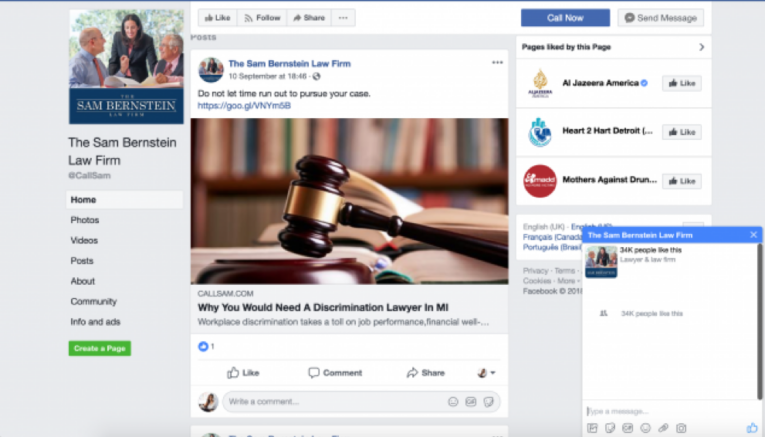
Use targeted audiences for your content
Audiences on Facebook are the best way to tailor your content strategy and posting schedule to those who like your page, as well as those who are friends of individuals who like your page. Targeted audiences allow you to “boost” or “promote” a post, gaining more views, clicks and engagement for a select segment of audiences.
Use Facebook Live for outreach
Video is one thing Facebook really pushes — but it also only favors “native” video content. To keep things accessible and keep the user on their platform, Facebook arms Business Pages with the ability to broadcast “live” sessions known as “Facebook Live”. Lawyers and legal brands can use Facebook Live videos to create “Q&A” themed sessions or days, or even post up “office hours”, where audiences can ask questions and gain solutions from experienced practitioners.
Remember that effective social media marketing is all about giving value, up front, to your end client.
Keep your information updated
Facebook Business Pages are a point of contact and a content hub for your brand. Building your profile and keeping your information updated is like managing a listing. Like Google, Facebook Pages also act as a point of information for your audiences who are looking to learn more about you, see your physical location and head to your website.
Track traffic from Facebook with Google Analytics
If you want to know if your Facebook engagement and content strategy is working, here’s a neat hack. Hook up your Facebook to your Google Analytics dashboard and track how much of your traffic is coming from your Facebook Business Page. This way, you’ll be able to determine if Facebook is a useful source of traffic and you can turn your attention towards communicating with your audiences on there over other platforms.
Dont’s
Set up an ad without a strategy
Every ad requires a strategy behind it. Your audiences will be targeted and then retargeted, as individual users and audience members work their way through your “Facebook Ads” funnel. But that funnel is something you’ll need to map out — starting with an opt-in that will reward your audience, or a blog post that will serve to answer their questions or bring greater clarity on an issue, empowering them to take action.
Miss out on using Lookalike Audiences
Lookalike audiences are one of the most powerful features of an already powerful Power Editor and Ads Manager. Lookalike audiences essentially help you do two things at once: build your list and create a potentially “unlimited” stream of new leads.
Use chatbots without a human element
Just like Instagram bots, Facebook Messenger can sometimes have a canned response feeling to its introductions. While it’s okay to use these pre-formatted messages as an invitation to learn more or as a call to action to reach out and contact your firm, using the Messenger function works best when there is a real human behind it.
Spam others in groups
If you’re joining groups in order to connect with other contemporaries in your niche, share marketing tips and keep updated on the latest goings on, you’ll want to make sure you’re following the rules of the group. The admins of many of the groups have rules stated up front — and this usually includes rules against constant self-promotion or blatant advertising. However the creators of Facebook Groups usually also allocate special theme days for sharing your business website or Twitter account.
Use inconsistently branded graphics
Remember that your business page is for cementing your brand. It should have all the hallmarks of your legal brand, including your logo, brand colors and branded graphics. Since your posts will be a combination of external content as well as your own blog content, it’s important to have a cohesive look to all.
So go ahead. Pull out a legal pad and start creating your new list of “Things to Do” to get social media working for your firm.
About Us
Did you know more than 200 clients have worked with PaperStreet for more than 10 years?
Get a Free Website
Analysis and Consultation
Marketing Services



